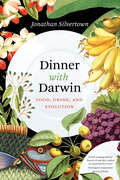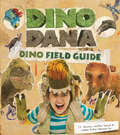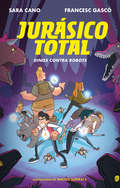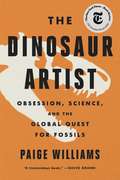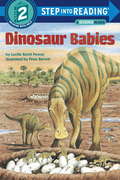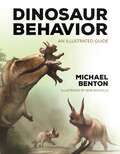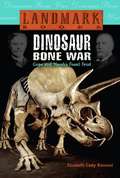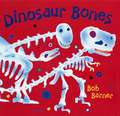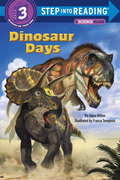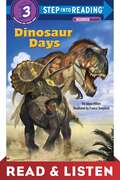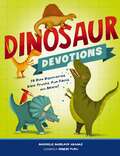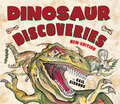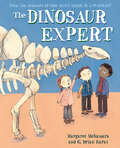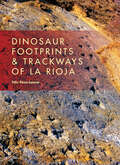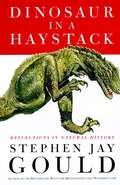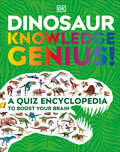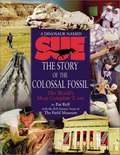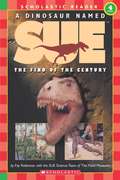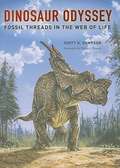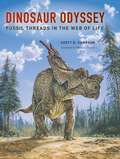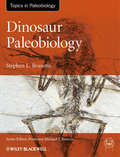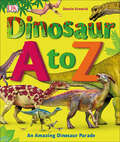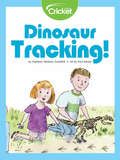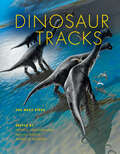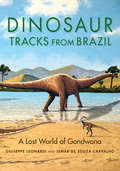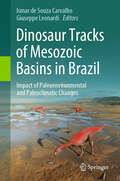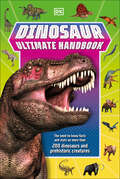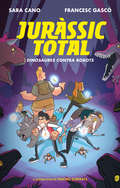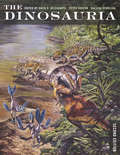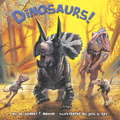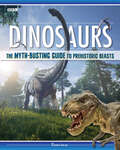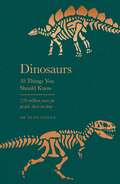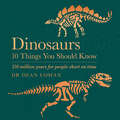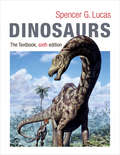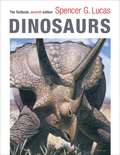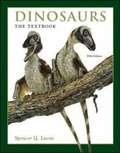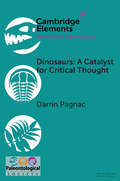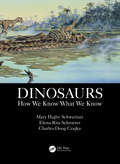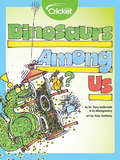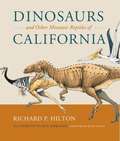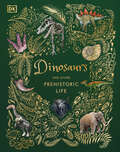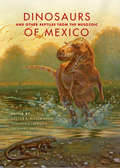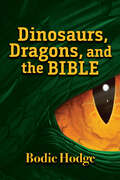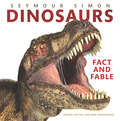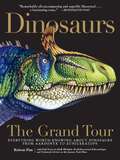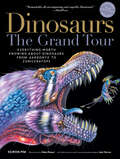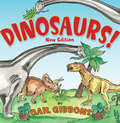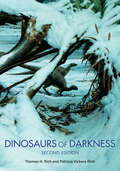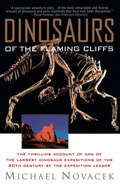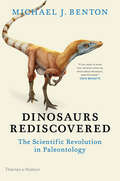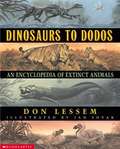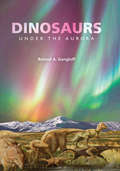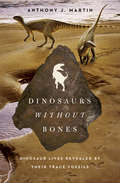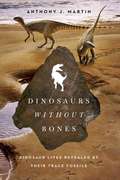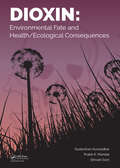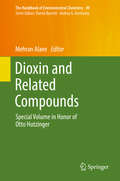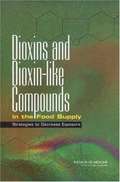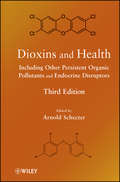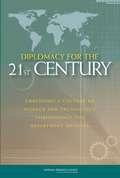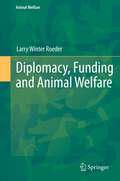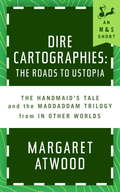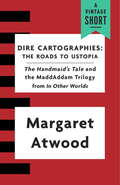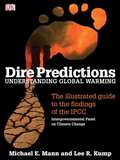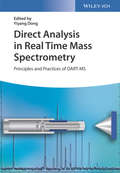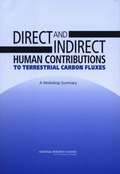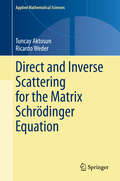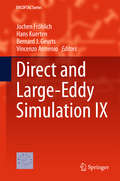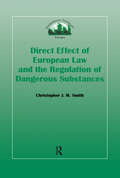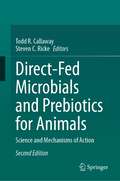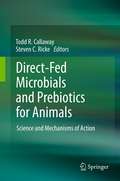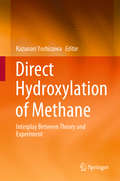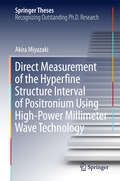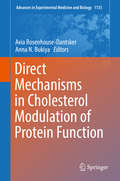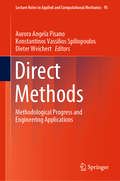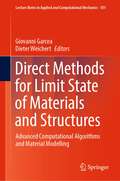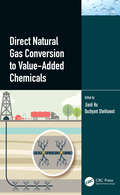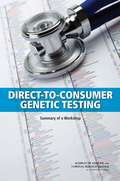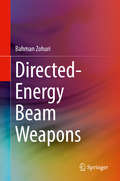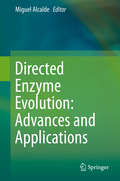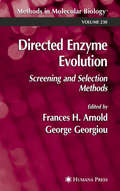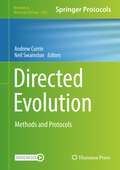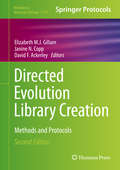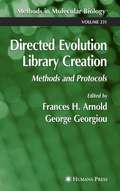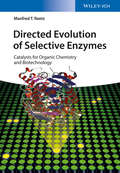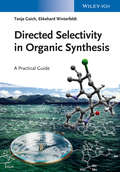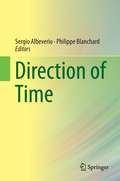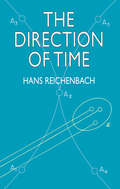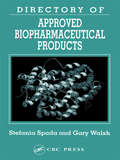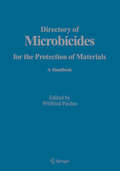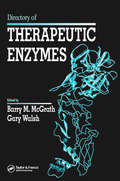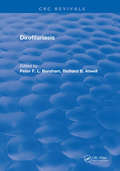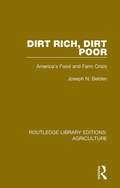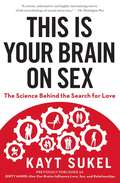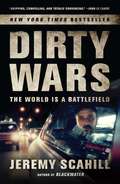- Table View
- List View
Dingos (Australian Animal Discovery Library)
by Lynn M. StoneFrom the book Jacket: Describes the physical characteristics, behavior, natural habitat, and relationship to humans of the Australian wild dog known as the dingo THE AUSTRALIAN ANIMAL LIBRARY Discover six of the weird and wonderful animals of Australia, the island continent "down under." Read about their curious habits, their conflicts with peoplt and their future. Crocodiles Dingoes Kangaroos Koalas Tasmanian Devils Wombats
Dinner with Darwin: Food, Drink, and Evolution
by Jonathan SilvertownWhat do eggs, flour, and milk have in common? They form the basis of waffles, of course, but these staples of breakfast bounty also share an evolutionary function: eggs, seeds (from which we derive flour by grinding), and milk have each evolved to nourish offspring. Indeed, ponder the genesis of your breakfast, lunch, or dinner, and you’ll soon realize that everything we eat and drink has an evolutionary history. In Dinner with Darwin, join Jonathan Silvertown for a multicourse meal of evolutionary gastronomy, a tantalizing tour of human taste that helps us to understand the origins of our diets and the foods that have been central to them for millennia—from spices to spirits. A delectable concoction of coevolution and cookery, gut microbiomes and microherbs, and both the chicken and its egg, Dinner with Darwin reveals that our shopping lists, recipe cards, and restaurant menus don’t just contain the ingredients for culinary delight. They also tell a fascinating story about natural selection and its influence on our plates—and palates. Digging deeper, Silvertown’s repast includes entrées into GMOs and hybrids, and looks at the science of our sensory interactions with foods and cooking—the sights, aromas, and tastes we experience in our kitchens and dining rooms. As is the wont of any true chef, Silvertown packs his menu with eclectic components, dishing on everything from Charles Darwin’s intestinal maladies to taste bud anatomy and turducken. Our evolutionary relationship with food and drink stretches from the days of cooking cave dwellers to contemporary crêperies and beyond, and Dinner with Darwin serves up scintillating insight into the entire, awesome span. This feast of soup, science, and human society is one to savor. With a wit as dry as a fine pinot noir and a cache of evolutionary knowledge as vast as the most discerning connoisseur’s wine cellar, Silvertown whets our appetites—and leaves us hungry for more.
Dino Dana: Dino Field Guide
by J.J. Johnson Christin Simms Colleen Russo JohnsonA Dino Dana Field Guide of Dinosaurs for Kids (Ages 8-12)“This field guide is great for new and old dinosaur lovers. It alphabetically introduces dinosaurs and information about when and where they lived along with other tidbits about them. It is good for fun reading and can be used in homeschooling.” ―JustaBXMomNominated for Four Daytime Emmy® Awards#1 Bestseller in Children's Fossil BooksFun facts about dinosaurs for kids. Did you know that the brachiosaurus was the tallest dinosaur that we know of today? That the kosmoceratops had fifteen horns and hooks on its head? That the spinosaurus is the only known dinosaur to spend most of its time swimming? Discover this and much more in Dino Dana: Dino Field Guide.Dino Dana's field guide for your child. Fans of the Amazon Prime TV show Dino Dana will be so excited to have a Dino Field Guide of their own, put together by the incredible show's creator and executive producer, J. J. Johnson. Full of colorful illustrations and fascinating science facts, this dinosaur book is sure to amaze any young dino enthusiast.A great science book for kids. This book for children is perfect for any kid who likes history and science. In the Dino Dana field guide, your kids learn:Which time period each dinosaur lived inHow big the dinosaurs wereWhat kinds of things dinosaurs ate and did each dayAnd so much moreKids who like cool dinosaur books like Dinosaurs, National Geographic Little Kids First Big Book of Dinosaurs, The Big Book of Dinosaurs, or The Dinosaur Book will love Dino Dana: Dino Field Guide.
Dino-Pals Are Dino-Mite! Earth Is All the Home We Have
by Joanna Korba Gary FreemanFor the Mackey family, it seems to be life as we know it today. But will Liza's and Theo's new dinosaur-robot toys change everything? It's 3012, and Jim Smith and his family are leaving their home planet. Why? What will life be like on their new planet? Read these stories to find out.
Dinos contra robots (Serie Jurásico Total #Volumen 2)
by Sara Cano Francesc GascóNo te pierdas la segunda entrega de «Jurásico Total», la nueva serie de ciencia ficción y aventuras, y prepárate para embarcarte en un viaje alucinante a la era de los dinosaurios. Lucas, Carla, Dani, Leo y Elena han viajado a un lugar donde los dinosaurios siguen vivos. Y juntos han vivido una aventura increíble. Pero la tía de Lucas sigue desaparecida. Y existe un nuevo portal a Pangea. Esta vez, el equipo Jurásico Total cuenta con el apoyo de un grupo de científicos y robots alucinantes... Aunque no todos están de su lado. ¿Qué misterios descubrirán en esta aventura?
The Dinosaur Artist: Obsession, Betrayal, and the Quest for Earth's Ultimate Trophy
by Paige WilliamsIn 2012, a New York auction catalogue boasted an unusual offering: "a superb Tyrannosaurus skeleton." In fact, Lot 49135 consisted of a nearly complete T. bataar, a close cousin to the most famous animal that ever lived. The fossils now on display in a Manhattan event space had been unearthed in Mongolia, more than 6,000 miles away. At eight-feet high and 24 feet long, the specimen was spectacular, and when the gavel sounded the winning bid was over $1 million. <p><p> Eric Prokopi, a thirty-eight-year-old Floridian, was the man who had brought this extraordinary skeleton to market. A onetime swimmer who spent his teenage years diving for shark teeth, Prokopi's singular obsession with fossils fueled a thriving business hunting, preparing, and selling specimens, to clients ranging from natural history museums to avid private collectors like actor Leonardo DiCaprio. <p> But there was a problem. This time, facing financial strain, had Prokopi gone too far? As the T. bataar went to auction, a network of paleontologists alerted the government of Mongolia to the eye-catching lot. As an international custody battle ensued, Prokopi watched as his own world unraveled. <p> In the tradition of The Orchid Thief, The Dinosaur Artist is a stunning work of narrative journalism about humans' relationship with natural history and a seemingly intractable conflict between science and commerce. A story that stretches from Florida's Land O' Lakes to the Gobi Desert, The Dinosaur Artist illuminates the history of fossil collecting--a murky, sometimes risky business, populated by eccentrics and obsessives, where the lines between poacher and hunter, collector and smuggler, enthusiast and opportunist, can easily blur. <p> In her first book, Paige Williams has given readers an irresistible story that spans continents, cultures, and millennia as she examines the question of who, ultimately, owns the past.
Dinosaur Babies (Step into Reading)
by Lucille Recht Penner Peter BarrettIllus. in full color. Meet the cutest (and biggest!) babies of all time in the first nonfiction Step 1. The hatching of eggs, the habits, and the hazards faced by prehistoric toddlers are all here in this accurate, accessible look at a perennially popular subject.
Dinosaur Behavior: An Illustrated Guide
by Michael J. BentonA stunningly illustrated guide to these extraordinary creatures from a world-renowned paleontologistPaleobiology has advanced from a speculative subject to a cutting-edge science. Today, researchers are applying the latest forensic technologies to the fossil record, revealing startling new insights into the lives of dinosaurs. This illustrated guide explores the behavior, evolution, physiology, and extinction of dinosaurs, taking readers inside the mysterious world of these marvelous animals. With specially commissioned illustrations by Bob Nicholls, Dinosaur Behavior explains how the dinosaurs lived and courted, fought and fed, signaled and interacted with each other, and much more.Features a wealth of breathtaking illustrations throughoutOffers new perspectives on the prehistoric world inhabited by dinosaursSheds light on how dinosaurs actually looked, how they moved, and how fast they ranExplains the feeding habits of carnivores, herbivores, scavengers, and solitary huntersDiscusses sight, hearing, smell, spatial orientation, and intelligenceBrings to life the social behavior of dinosaurs, from mating and parenting to herd dynamics and migrationTakes readers behind the scenes of the latest, most thrilling discoveries
Dinosaur Bone War: Cope and Marsh's Fossil Feud
by Elizabeth Cody KimmelCope was a charming man with a passion for old bones. Marsh was a stickler for procedure when he studied his fossil finds. They shared ideas and information, but after Marsh tried to poach Cope's digging site, they became bitter enemies.
Dinosaur Bones
by Bob BarnerWith a lively rhyming text and vibrant, paper-collage illustrations, author-artist Bob Barner shakes the dust off the dinosaur bones found in museums and reminds readers that these fossils once belonged to living, breathing creatures. Filled with fun dinosaur facts (a Tyrannosaurus rex skull can weigh up to 750 pounds!) and an informational "Dinometer," Dinosaur Bones is sure to make young dinosaur enthusiasts roar with delight.
Dinosaur Days (Step into Reading)
by Joyce Milton Franco TempestaIllus. in full color. Difficult dinosaur names are simplified with phonics.
Dinosaur Days: Read & Listen Edition (Step into Reading)
by Joyce MiltonIllus. in full color. Difficult dinosaur names are simplified with phonics.
Dinosaur Devotions: 75 Dino Discoveries, Bible Truths, Fun Facts, and More!
by Michelle Medlock Adams Denise Turu“Michelle Medlock Adams has created a fun, lively devotional that’s sure to appeal to dinosaur lovers of all ages. Filled with fun dino facts, journaling prompts, and Scripture, Dinosaur Devotions shares truth from God's Word in a way that kids will understand and enjoy. What a great way to get children interested in the Bible."—Victoria Osteen, New York Times bestselling author and copastor of Lakewood Church in Houston, TexasDinosaur Devotions will help your middle grade children dig deeper into the Word while uncovering fascinating facts about dinosaurs! These 75 devotions also include segments like Dino Stats, Bible Excavation, Digging Deeper, Did You Know?, and Jurassic Journaling. Dinosaur Devotions blends fun dinosaur facts with a deeper understanding of God’s Word, making your child's faith journey an extra fun adventure!Award-winning author Michelle Medlock Adams offers Dinosaur Devotions—a fun way to help your dinosaur-loving kids connect with God. These 75 devotions include bright, colorful illustrations and uncover facts about specific dinosaur species while providing spiritual insight and easy-to-understand takeaways that will encourage your children to take their faith to the next level! Your kids will also love segments like Dino Stats (a dinosaur's measurements), Bible Excavation (a main Bible verse), Digging Deeper (self-reflection questions), Did You Know? (fun facts), and Jurassic Journaling (creative writing opportunities) that make this devotional interactive and even more memorable.
Dinosaur Discoveries (New & Updated)
by Gail GibbonsHere are the most recent theories about the history of dinosaurs, backed up with amazing facts about dinosaur discoveries. Gibbons discusses the Triassic, Jurassic, and Cretaccous periods and many of the non-bird dinosaurs that lived during each of those times.
The Dinosaur Expert (Mr. Tiffin's Classroom Series)
by Margaret McNamaraJoin Mr. Tiffin and his students on a trip to a natural history museum and learn all about dinosaurs and the scientists who discovered them!Mr. Tiffin and his students are back in another picture book, and this time the focus is on dinosaur-loving Kimmy. During a field trip to the natural history museum, Kimmy is thrilled to share what she knows about the Stegosaurus and the Archaeopteryx and even the ginormous Titanosaurus. That changes when one of her classmates questions whether girls can be paleontologists. Kimmy starts to feel shy. What if they can't? What if no one wants to hear what she has to say? It will take some help from Mr. Tiffin--and from a famous scientist--for Kimmy to find her voice again.Join Mr. Tiffin's class as they learn about dinosaurs big and small, feathered and scaly, winged and ocean-dwelling. And root for Kimmy, the dinosaur expert . . . who might just learn something about herself.
Dinosaur Footprints and Trackways of La Rioja (Life Of The Past Ser.)
by Félix Pérez-LorenteDuring the Early Cretaceous, lakes, meandering streams, and flood plains covered the region where the current foothills of Rioja now exist. Today the area is known for its wine and for the dozens of sites where footprints and trackways of dinosaurs, amphibians, and even pterosaurs can be seen. The dinosaurs that lived here 120 million years ago left their footsteps imprinted in the mud and moist soil. Now fossilized in rock, they have turned Rioja into one of the most valuable dinosaur footprint sites in all of Europe. Félix Pérez-Lorente and his colleagues have published extensively on the region, mostly in Spanish-language journals. In this volume, Pérez-Lorente provides an up-to-date synthesis of that research in English. He offers detailed descriptions of the sites, footprints, and trackways, and explains what these prints and tracks can tell us about the animals who made them.
Dinosaur in a Haystack: Reflections in Natural History
by Stephen Jay GouldA collection of 34 essays, most originally published in 'Natural History' magazine, in which the renowned evolutionary biologist and paleontologist muses on evolution, time, change, and history. Some intriguing topics addressed include why images of snails were printed backward in 17th century treatises on conchology and why schoolchildren are falsely taught that in the Middle Ages people thought the earth was flat.
Dinosaur Knowledge Genius: A Quiz Encyclopedia to Boost Your Brain (DK Knowledge Genius)
by DKPut your dinosaur knowledge to the test with this brilliant quiz book for kids!Introducing Dinosaur Knowledge Genius! - a brilliant quiz book packed with over 80 topics on the fascinating prehistoric world of dinosaurs. Which were the most fearsome predators? How big were the most gigantic plant-eaters? Why did so many dinosaurs have frills, crests, or spikes? Did dinosaurs really lay eggs? Which ones had feathers? If you want to know the answers, then this may be the book for you! Take on this brain-busting challenge about prehistoric life.This dinosaur quiz book for children aged 9-12 offers: - Plenty of quiz questions throughout the book to put your knowledge to the test.- Interactive &“Test Yourself&” panel lists with three levels of difficulty - starter, challenger, and genius.- Impressive dinosaur graphics that jump out at you on every page.- A variety of fun facts, picture puzzles, and quiz questions to keep kids entertained and engaged.As you hop from one dinosaur species to the next, you will learn all about the fascinating prehistoric world in this entertaining quiz book for kids and the whole family to enjoy. The pages are packed with eye-popping pictures and the "Test Yourself" panels list the type of dinosaur you&’re looking for on the page. With three levels of difficulty, the challenge gets harder from Starter to Challenger and the truly tricky Genius category. There's a fun fact with every picture to give a helpful clue.At DK, we believe in the power of discovery. So why stop here? Why not put your general knowledge to the test with other books in the Knowledge Genius series? Try General Knowledge Genius! to learn about everything, explore the animal world with Animal Knowledge Genius! or explore our planet with Earth Knowledge Genius!
A Dinosaur Named Sue: The World's Most Complete T. Rex
by Patricia RelfRelf and the SUE Science Team of The Field Museum track the story of largest and most complete T. rex fossil ever found, beginning with its discovery in 1990 in South Dakota, and leading up to its unveiling at the Field Museum in Chicago in 2000.
A Dinosaur Named Sue: The Find of the Century
by Fay RobinsonFound in the Badlands of South Dakota in 1990, "Sue" the dinosaur is the largest and most complete T-Rex fossil ever discovered. Young readers can learn about her amazing story, from the beginning to the exciting restoration work leading up to her spring 2000 debut.
Dinosaur Odyssey: Fossil Threads in the Web of Life
by Scott D. SampsonSituating the fascinating animals in a broad ecological and evolutionary context, leading dinosaur expert Scott D. Sampson fills us in on the exhilarating discoveries of the past twenty-five years, the most active period in the history of dinosaur paleontology, during which more "new" species were named than in all prior history.
Dinosaur Odyssey: Fossil Threads in the Web of Life
by Scott D. Sampson Philip J. CurrieThis captivating book, laced with evocative anecdotes from the field, gives the first holistic, up-to-date overview of dinosaurs and their world for a wide audience of readers. Situating these fascinating animals in a broad ecological and evolutionary context, leading dinosaur expert Scott D. Sampson fills us in on the exhilarating discoveries of the past twenty-five years, the most active period in the history of dinosaur paleontology, during which more "new" species were named than in all prior history. With these discoveries--and the most recent controversies--in mind, Sampson reconstructs the odyssey of the dinosaurs from their humble origins on the supercontinent Pangaea, to their reign as the largest animals the planet has ever known, and finally to their abrupt demise. Much more than the story of who ate whom way back when, Dinosaur Odyssey places dinosaurs in an expansive web of relationships with other organisms and demonstrates how they provide a powerful lens through which to observe the entire natural world. Addressing topics such as extinction, global warming, and energy flow, Dinosaur Odyssey finds that the dinosaurs' story is, in fact, a major chapter in our own story.
Dinosaur Paleobiology
by Stephen L. BrusatteThe study of dinosaurs has been experiencing a remarkable renaissance over the past few decades. Scientific understanding of dinosaur anatomy, biology, and evolution has advanced to such a degree that paleontologists often know more about 100-million-year-old dinosaurs than many species of living organisms. This book provides a contemporary review of dinosaur science intended for students, researchers, and dinosaur enthusiasts. It reviews the latest knowledge on dinosaur anatomy and phylogeny, how dinosaurs functioned as living animals, and the grand narrative of dinosaur evolution across the Mesozoic. A particular focus is on the fossil evidence and explicit methods that allow paleontologists to study dinosaurs in rigorous detail. Scientific knowledge of dinosaur biology and evolution is shifting fast, and this book aims to summarize current understanding of dinosaur science in a technical, but accessible, style, supplemented with vivid photographs and illustrations.The Topics in Paleobiology Series is published in collaboration with the Palaeontological Association, and is edited by Professor Mike Benton, University of Bristol.Books in the series provide a summary of the current state of knowledge, a trusted route into the primary literature, and will act as pointers for future directions for research. As well as volumes on individual groups, the series will also deal with topics that have a cross-cutting relevance, such as the evolution of significant ecosystems, particular key times and events in the history of life, climate change, and the application of a new techniques such as molecular palaeontology.The books are written by leading international experts and will be pitched at a level suitable for advanced undergraduates, postgraduates, and researchers in both the paleontological and biological sciences.Additional resources for this book can be found at: http://www.wiley.com/go/brusatte/dinosaurpaleobiology.
Dinosaur A to Z
by Dustin GrowickA catalog of more than 150 dinosaurs and other prehistoric creatures—listed in alphabetical order from Abelisaurus to Zuniceratops—that is perfect for children as young as five.Written by American Museum of Natural History educator Dustin Growick, Dinosaur A to Z is a colorful parade of the most exciting creatures that have ever lived and provides a line-up of the biggest, smallest, baddest, nicest, scaliest, and everything-in-between dinosaurs that have been discovered to date, as well as other prehistoric creatures of the air, land, and sea. Specially commissioned CGI images of children alongside the dinosaurs illustrate exactly how big—or small—each one was in comparison, and children can learn how to pronounce dinosaur names and discover the meaning behind each, and learn about different dinosaur shapes, sizes, and meals.Dinosaur A to Z is the perfect first visual dictionary for little dinosaur enthusiasts.
Dinosaur Tracking!
by Kathleen Weidner ZoehfeldYoung Carla finds some strange looking footprints in the backyard, and her family makes a trip to the museum to figure out what left them. They learn about the relationship between birds and dinosaurs.
Dinosaur Tracks: The Next Steps (Life Of The Past Ser.)
by Annette Richter Peter L. Falkingham Daniel MartyThe latest advances in dinosaur ichnology are showcased in this comprehensive and timely volume, in which leading researchers and research groups cover the most essential topics in the study of dinosaur tracks. Some assess and demonstrate state-of-the-art approaches and techniques, such as experimental ichnology, photogrammetry, biplanar X-rays, and a numerical scale for quantifying the quality of track preservation. The high diversity of these up-to-date studies underlines that dinosaur ichnological research is a vibrant field, that important discoveries are continuously made, and that new methods are being developed, applied, and refined. This indispensable volume unequivocally demonstrates that ichnology has an important contribution to make toward a better understanding of dinosaur paleobiology. Tracks and trackways are one of the best sources of evidence to understand and reconstruct the daily life of dinosaurs. They are windows on past lives, dynamic structures produced by living, breathing, moving animals now long extinct, and they are every bit as exciting and captivating as the skeletons of their makers.
Dinosaur Tracks from Brazil: A Lost World of Gondwana (Life of the Past)
by Giuseppe Leonardi Ismar de Souza CarvalhoDinosaur Tracks from Brazil is the first full-length study of dinosaurs in Brazil. Some 500 dinosaur trackways from the Cretaceous period still remain in the Rio do Peixe basins of Brazil, making it one of the largest trackways in the world. Veteran paleontologists Giuseppe Leonardi and Ismar de Souza Carvalho painstakingly document and analyze each track found at 37 individual sites and at approximately 96 stratigraphic levels. Richly illustrated and containing a wealth of data, Leonardi and de Souza Carvalho brilliantly reconstruct the taxonomic groups of the dinosaurs from the area and show how they moved across the alluvial fans, meandering rivers, and shallow lakes of ancient Gondwana. Dinosaur Tracks from Brazil is essential reading for paleontologists.
Dinosaur Tracks of Mesozoic Basins in Brazil: Impact of Paleoenvironmental and Paleoclimatic Changes
by Ismar de Souza Carvalho Giuseppe LeonardiThis book presents the diversity of Dinosaur tracks found in Mesozoic basins in Brazil and brings it in a paleoenvironmental context. Each chapter includes information about the geology of the site, the distribution of the footprints, their diversity as well as a paleontological interpretation. The book provides information about the paleoenvironmental and paleoclimatic aspects of the Mesozoic. All chapters contain a geological map, images of the footprints and dinosaur tracks and a reconstruction of the environment in which the tracks were found. The book is aimed at geoscientists and paleontologists, including researchers which focus on evolution subjects.
Dinosaur Ultimate Handbook: The Need-To-Know Facts and Stats on Over 150 Different Species (DK's Ultimate Handbook)
by DKTravel back in time and meet the incredible creatures of the prehistoric world with this children's educational book about dinosaurs.Welcome to the world of dinosaurs! From the Stegosaurus to the Tyrannosaurus-rex, get ready to dig into the past and bring dinosaurs to life with this dino-mite encyclopedia for children!Inside the pages of this dinosaur book for children, you'll discover: - Full of modern, colorful and detailed illustrations with a distinct "gamer" style design. - Jam-packed with essential facts and figures on more than 200 different species. - Special features about dinosaur diet, habitat, communication and more. - Action-packed Battle Up! spreads show which dinosaurs would win in a fight. - Extra reference spreads are packed with information, teaching children about prehistoric plants, dinosaur diets, flying reptiles and much, much more.- Incredible double spread images of dinosaurs in situ are interspersed throughout the book.This superb fact-packed dinosaur reference book contains everything you've ever wanted to know about dinosaurs of every shape and size! Learn how to tell the difference between carnivores and herbivores or the Jurassic and Triassic periods. With details on dinosaur habitats, dinosaurs of the sea and sky, prehistoric beasts, and who would win in a battle, you will be able to answer any question on how the world was 250 million years ago.The chapters are divided chronologically and contain a list of more than 200 different species of dinosaurs and prehistoric creatures. Each animal profile is packed with vital statistics, unique facts about dinosaurs, and a size chart comparing them to humans, so you will be able to see how you shape up to these Triassic titans. Perfect for dino-lovers age 6 and up, Dinosaur Ultimate Handbook will help cultivate the paleontologists of tomorrow!
Dinosaures contra robots (Sèrie Juràssic Total #Volumen 2)
by Sara Cano Francesc GascóNo et perdis el segon volum de «Juràssic Total», la nova sèrie de ciència ficció i aventures, i prepara't per embarcar-te en un viatge al·lucinant a l'era dels dinosaures. El Lucas, la Carla, el Dani, el Leo i l'Helena han viatjat a un lloc en el qual els dinosaures continuen vius. I junts han viscut una aventura increïble. Però la tieta del Lucas segueix desapareguda. I existeix un nou portal a Pangea. Aquest cop, el grup Juràssic Total compta amb el suport d'un equip de científics i robots al·lucinants... tot i que no tots estan de la seva banda. Quins misteris descobriran en aquesta aventura?
The Dinosauria
by Halszka Osmólska David B. Weishampel Peter DodsonWhen the The Dinosauria was first published more than a decade ago, it was hailed as "the best scholarly reference work available on dinosaurs" and "an historically unparalleled compendium of information." This second, fully revised edition continues in the same vein as the first but encompasses the recent spectacular discoveries that have continued to revolutionize the field. A state-of-the-science view of current world research, the volume includes comprehensive coverage of dinosaur systematics, reproduction, and life history strategies, biogeography, taphonomy, paleoecology, thermoregulation, and extinction. Its internationally renowned authors--forty-four specialists on the various members of the Dinosauria--contribute definitive descriptions and illustrations of these magnificent Mesozoic beasts. The first section of The Dinosauria begins with the origin of the great clade of these fascinating reptiles, followed by separate coverage of each major dinosaur taxon, including the Mesozoic radiation of birds. The second part of the volume navigates through broad areas of interest. Here we find comprehensive documentation of dinosaur distribution through time and space, discussion of the interface between geology and biology, and the paleoecological inferences that can be made through this link. This new edition will be the benchmark reference for everyone who needs authoritative information on dinosaurs.
Dinosaurs: Over 100 Questions and Answers to Things You Want to Know
by Dan Abnett Nik VincentDid the dinosaurs have armor? Were dinosaurs good parents? Why did the dinosaurs become extinct? Dinosaurs How big were the dinosaurs? Where in the world did the dinosaurs live? You'll find the answers to these and over 100 other intriguing questions inside this beautifully illustrated book.
Dinosaurs! (Pictureback(R))
by Robert T. BakkerDinosaurs! follows the evolution of these spectacular creatures from their earliest beginnings as little fellows who had to evade attacks from giant croc relatives to today's living dinosaurs.
Dinosaurs: The Myth-busting Guide to Prehistoric Beasts
by BBC ScienceFocusFrom the BBC, a book &“packed with facts and illustrations on the latest finds and theories for dinosaur enthusiasts of all ages.&” —Mike Fredericks, Editor, Prehistoric Times Magazine If everything you know about dinosaurs comes from Hollywood movies, get ready for some surprises in this lively, myth-busting book. The latest scientific research is changing assumptions and providing a far different perspective on these magnificent creatures. Rather than being slow, lumbering and a bit stupid, dinosaurs were smart and nimble-brained—just ask the paleontologists who are peering deep inside the fossilized skulls of these prehistoric animals. Learn how dinosaurs conquered the world, what would have happened if the asteroid hadn't hit Mexico, what T. rex really looked (and sounded) like, and the modern-day dinosaurs living in your back yard. Loaded with in-depth articles and stunning color illustrations, Dinosaurs: The Myth-Busting Guide to Prehistoric Beasts is the ultimate guide to the newest dinosaur discoveries. &“Fun and fascinating . . . find out how the real dinosaurs lived their lives, what they looked like, how they sounded, and how we know all that!&” —Midwest Book Review This is a fixed-format ebook, which preserves the design and layout of the original print book
Dinosaurs: 10 Things You Should Know
by Dr Dean Lomax'A warp-speed tour of dinosaurs, with an expert guide' PROF. STEVE BRUSATTE, bestselling author of The Rise and Fall of Dinosaurs'A fun, speedy read for grown-ups who love dinosaurs - a great way to get into the subject' PROF. MICHAEL BENTON, author of The Dinosaurs Rediscovered---------Travel back to the prehistoric world and discover the most fascinating parts of the lives of Earth's most awe-inspiring creatures - the dinosaurs. Dr Dean Lomax brings these prehistoric creatures to life in ten bite-sized essays, written for people short on time but not curiosity. Making big ideas simple, Dean takes readers on a journey to uncover what makes a dinosaur a dinosaur, what dinosaurs ate, how they evolved, what caused them to go extinct, and more! Perfect for anyone fascinated by the dinosaur exhibits at museums, palaeontology and fans of Jurassic Park.
Dinosaurs: 10 Things You Should Know
by Dr Dean Lomax'A warp-speed tour of dinosaurs, with an expert guide' PROF. STEVE BRUSATTE, bestselling author of The Rise and Fall of Dinosaurs'A fun, speedy read for grown-ups who love dinosaurs - a great way to get into the subject' PROF. MICHAEL BENTON, author of The Dinosaurs Rediscovered---------Travel back to the prehistoric world and discover the most fascinating parts of the lives of Earth's most awe-inspiring creatures - the dinosaurs. Dr Dean Lomax brings these prehistoric creatures to life in ten bite-sized essays, written for people short on time but not curiosity. Making big ideas simple, Dean takes readers on a journey to uncover what makes a dinosaur a dinosaur, what dinosaurs ate, how they evolved, what caused them to go extinct, and more! Perfect for anyone fascinated by the dinosaur exhibits at museums, palaeontology and fans of Jurassic Park.---------'An eminently accessible read...a perfect primer (or refresher) for dino fans and newbies, yet doesn't skimp on the fascinating details that make 21st-century palaeontology so vibrant' DR REBECCA WRAGG SYKES, author of Kindred
Dinosaurs: The Textbook (Topics In Geobiology Ser. #51)
by Spencer LucasGeared towards a broad variety of students, Dinosaurs: The Textbook, sixth edition, is a concise and lucid presentation of the biological and geological concepts of dinosaur science. It clarifies the evolution, phylogeny, and classification of the various species while modeling the best approach for navigating new and existing research. Revised to reflect recent fossil discoveries and the current consensus on dinosaur science, this text moves through the major taxonomic groups—including theropods, sauropodomorphs, ornithopods, ceratopsians, pachycephalosaurs, stegosaurs, and ankylosaurs—and concludes with updated chapters on the behavior and extinction of the dinosaurs, their biological relationship to birds, and their representation (or misrepresentation) in art, literature, film, and other forms of popular culture.The sixth edition represents a major revision of the leading text for an introductory course on dinosaurs, including comprehensive updates based on the latest scientific discoveries, research, and literature. With an extensive art program revised by leading paleoartists that features cutting-edge illustrations, it is a complete reader-friendly pedagogical package with extensive end-of-chapter summary tools, review questions, a detailed glossary, a dinosaur dictionary, and a comprehensive index. Please visit our supplemental materials page (https://cup.columbia.edu/extras/supplement/dinosaurs-the-textbook-sixth-edition) to find study and teaching aides for both students and teachers using Dinosaurs: The Textbook, sixth edition in class.
Dinosaurs: The Textbook
by Spencer LucasGeared toward a broad variety of students, Dinosaurs: The Textbook offers a concise and lucid presentation of the core biological and geological concepts of dinosaur science. Revised throughout to reflect recent fossil discoveries and the current scientific consensus, this seventh edition details the evolution, phylogeny, and classification of various dinosaur species while modeling the best approach for navigating new and existing research.Spencer G. Lucas takes readers through the major taxonomic groups, including theropods, sauropodomorphs, ornithopods, ceratopsians, pachycephalosaurs, stegosaurs, and ankylosaurs. He also examines the behavior and extinction of the dinosaurs, their biological relationship to birds, and their representation (or misrepresentation) in art, literature, film, and other forms of popular culture.This seventh edition of the leading text for introductory courses on dinosaurs incorporates comprehensive updates based on the latest research. Lucas highlights how dinosaur science is rapidly evolving, exploring how new discoveries, methods, and ideas are expanding the frontiers of knowledge. The book features cutting-edge and scientifically rigorous illustrations by leading paleoartists. It also includes extensive and reader-friendly end-of-chapter summary tools, review questions, a detailed glossary, a dinosaur dictionary, and a comprehensive index.
Dinosaurs: The Textbook (Fifth Edition)
by Spencer George LucasTakes students on a journey through various aspects of dinosaur biology, geology, and the history of their discovery. This book presents facts together with ideas, notions, and controversies. It presents dinosaurs as successful, living creatures that were merely different in appearance from other animals.
Dinosaurs: A Catalyst for Critical Thought (Elements of Paleontology)
by Darrin PagnacUniversity dinosaur courses provide an influential venue for developing aptitude beyond knowledge of terrestrial Mesozoic reptiles. Passion for dinosaurs, when properly directed, can trigger interest in science and be used to develop critical thinking skills. Examination of dinosaur paleontology can develop competence in information analysis, perception of flawed arguments, recognition of persuasion techniques, and application of disciplined thought processes. Three methods for developing critical thought are outlined in this book. The first uses dinosaur paleontology to illustrate logical fallacies and flawed arguments. The second is a method for evaluating primary dinosaur literature by students of any major. The final example entails critique of dinosaur documentaries based on the appearance of dinosaurs and the disconnect between scientific fact and storytelling techniques. Students are owed more than dinosaur facts; lecturers should foster a set of skills that equips students with the tools necessary to be perceptive citizens and science advocates.
Dinosaurs: How We Know What We Know
by Mary Higby Schweitzer Elena Rita Schroeter Charles Doug CzajkaThis textbook introduces research on dinosaurs by describing the science behind how we know what we know about dinosaurs. A wide range of topics is covered, from fossils and taphonomy to dinosaur physiology, evolution, and extinction. In addition, sedimentology, paleo-tectonics, and non-dinosaurian Mesozoic life are discussed. There is a special opportunity to capitalize on the enthusiasm for dinosaurs that students bring to classrooms to foster a deeper engagement in all sciences. Students are encouraged to synthesize information, employ critical thinking, construct hypotheses, devise methods to test these hypotheses, and come to new defensible conclusions, just as paleontologists do. Key Features Clear and easy to read dinosaur text with well-defined terminology Over 600 images and diagrams to illustrate concepts and aid learning Reading objectives for each chapter section to guide conceptual learning and encourage active reading Companion website (teachingdinosaurs.com) that includes supporting materials such as in-class activities, question banks, lists of suggested specimens, and more to encourage student participation and active learning Ending each chapter with a specific "What We Don’t Know" section to encourage student curiosity Related Titles Singer, R. Encyclopedia of Paleontology (ISBN 978-1-884964-96-1) Fiorillo, A. R. Alaska Dinosaurs: An Ancient Arctic World (ISBN 978-1-138-06087-6) Caldwell, M. W. The Origin of Snakes: Morphology and the Fossil Record (ISBN 978-1-4822-5134-0)
Dinosaurs Among Us
by Dr Gary GalbreathThere are dinosaurs still around today. We call them "birds."
Dinosaurs and Other Mesozoic Reptiles of California
by Richard P. Hilton Ken KirklandOne of the most geologically complex and diverse states, California spent much of the age of dinosaurs under water. While most of the fossils found in the state are those of reptiles that lived in the sea (thalattosaurs, ichthyosaurs, mosasaurs, plesiosaurs, and turtles), some are those of birds and pterosaurs that soared above it. Other fossils come from terrestrial animals that died and were washed into the ocean. These include turtles, crocodiles, lizards, and dinosaurs such as armored ankylosaurs, duck-billed hadrosaurs, and a variety of carnivorous dinosaurs. Richard Hilton is the first to tell the unsung story of the dinosaurs and reptiles of land, sea, and sky that lived in California and Baja California during the Mesozoic era (245 million-65 million years ago), in addition to the history of their discovery. Vibrantly illustrated with more than three hundred photographs, paintings, and drawings, this book provides geological and environmental details, describes the significance of the major fossils, and chronicles the adventures involved in the discovery, preparation, and publishing of the finds. Hilton also includes accounts of the scientists, teachers, students, ranchers, and weekend fossil hunters who endured (and continue to endure) harsh weather, fires, wild animals, and the usual challenges of fieldwork to collect fossil remains and make major discoveries. These enthusiasts managed to safeguard an abundance of fossil resources, some of which would otherwise have been destroyed by quarrying, paving, and housing developments. Dinosaurs and Other Mesozoic Reptiles of California takes this legacy one step further by documenting information about the fossils and their finders in accessible prose and vivid artistic renderings, creating a valuable contribution to our understanding of California's prehistoric past.
Dinosaurs and Other Prehistoric Life (DK Children's Anthologies)
by Professor Anusuya Chinsamy-TuranA comprehensive pocket guide to dinosaurs and prehistoric animals and the world they inhabited millions of years ago. Packed with more than seven hundred full-color illustrations, this definitive pocket guide paints a vivid portrait of extraordinary dinosaurs and prehistoric animals, and the ecosystems they lived in millions of years ago. This guide features authoritative text, crystal-clear illustrations, and a straightforward approach to revealing the fascinating lives and habitats of dinosaurs, pterosaurs, marine reptiles, and prehistoric beasts. The introductory section explains classification systems, geological timelines, the evolution of the dinosaurs, and how fossils form and are discovered by paleontologists. For ease of reference, the main body of the book is divided into three sections: the Precambrian and Paleozoic eras, when animals first began evolving; the Mesozoic era, which saw the flourishing and eventual extinction of the dinosaurs; and the Cenozoic era, when giant mammals walked the Earth. Each section is broken down into its geological time periods, and, within these, the species are organized according to habitat--whether they lived on land, in the water, or in the air.There are detailed profiles of 200 dinosaurs and other ancestors of modern animals. Each entry combines a precise, jargon-free description with full-color illustrations, skeletons, and replica models, annotated to showcase the unique features of the species. Maps show where each animal's fossils have been found, and many profiles are supported by photographs to show actual excavation sites.
Dinosaurs and Other Reptiles from the Mesozoic of Mexico
by Héctor E. Rivera-Sylva Eberhard Frey Kenneth CarpenterThis overview of dinosaur discoveries in Mexico synthesizes current information about the geography and environment of the region during the Mesozoic when it was the western margin of the ancient continent of Pangea. The book summarizes research on various groups, including turtles, lepidosauromorphs, plesiosaurs, crocodyliforms, pterosaurs, and last but not least, dinosaurs. In addition, chapters focus on trackways and other trace fossils and on K/P boundary (the Chicxulub crater, beneath the Gulf of Mexico, has been hypothesized as the site of the boloid impact that killed off the dinosaurs). Dinosaurs and Other Reptiles from the Mesozoic of Mexico is an up-to-date, informative volume on an area that has not been comprehensively described until now.
Dinosaurs, Dragons, and the Bible
by Bodie HodgeDinosaurs, Dragons, and the Bible is a one-of-a kind Christian apologetic resource sure to captivate families, scientists, historians, and theologians! Using the Bible as the absolute authority, Bodie Hodge of Answers in Genesis, the Creation Museum, and the Ark Encounter, provides answers to the most asked questions about these amazing creatures. As Christians, we must not ignore what the Scriptures say about dinosaurs and dragons and accept the secular world’s wisdom. This #ProBible handbook offers fascinating answers based on fossil footprints, soft tissue, biblical references to dragons, serpents, and leviathans, and much more. Go beyond the Hollywood version of these magnificent creatures to discover the truth of these icons of Creation and testaments of God’s power in the Genesis Flood. Designed for almost all ages, the book answers questions such as: How Did Huge Dinosaurs Fit on the Ark? Are Dinosaurs and Dragons the Same Thing? How Do I Use the Bible as the Framework to Look at Dinosaurs? Were Dinosaurs on Noah’s Ark (and Did Any Go Extinct Before the Flood)? Are Dinosaur Fossils in the Cretaceous, Jurassic, and Triassic Rock Millions of Years Old or from the Flood? Why Don’t We Find the Word “Dinosaur” in the Bible? Are There Any Human and Dinosaur Fossils Buried Together? Dinosaurs are nearly synonymous with evolution in the minds of much of the world. Studying these answers will help Christian families, church leaders, scientists, and theologians develop greater faith in the infallibility of God’s Word and His role as Creator. A Note from the author, Bodie Hodge: “I want to encourage parents and churches to be able to respond biblically to the secular attacks (war) on our children. So, as any good General would do in times of war, we need to study our opponent and know exactly what the secular side is teaching our children. Then, get equipped with solid biblical answers from our highest commanding officer (God and His Word) to defend our children against the attacks. Then, teach this knowledge diligently and apologetically to the next generation, like parents and churches are supposed to do (e.g., Ephesians 6:4-11, 2 Timothy 3:16–17).”
Dinosaurs: Fact and Fable
by Seymour Simon“If you love dinosaurs, you’ll love this book."— Steve Brusatte, paleontologist at the University of Edinburgh and New York Times bestselling author of The Rise and Fall of the DinosaursJoin award-winning science writer Seymour Simon as he separates fact from fiction in a brilliant exploration of some of the most fascinating creatures to ever roam the planet: dinosaurs! This nonfiction picture book is an excellent choice for both shared and independent reading during homeschooling and classroom learning, in particular for children ages 6 to 8.Scientists have dug up and uncovered many facts about dinosaurs—and in the process, they have come across many myths. This picture book digs deep into the Age of Dinosaurs, covering topics such as fossilization, plate tectonics, dinosaur diets, paleontology, extinction theories, dinosaur relatives, and more!Get ready to learn what we know about dinosaurs and what we still don’t know, and about the amazing new discoveries being made every single day.Perfect for young scholars’ school reports, Dinosaurs: Fact and Fable features clear text, vibrantly colored pages, engaging sidebars, and stunning full-color illustrations and photographs. This book includes an author's note, a glossary, a timeline, and an index and supports the Common Core State Standards.Check out these other Seymour Simon books about animals:Big CatsButterfliesCatsCrocodiles & AlligatorsDogsDolphinsElephantsFrogsGorillasHorsesInsectsPenguinsSea CreaturesSnakesSpidersWhalesWild BabiesWolves
Dinosaurs - The Grand Tour: Everything Worth Knowing About Dinosaurs from Aardonyx to Zuniceratops
by Keiron Pim Jack HornerFrom Aardonyx to Zuniceratops—A Dino-Mite Gathering of All the Dinosaurs (More Than 300!) Worth Knowing About We live in a golden age of paleontological discovery—the perfect time to dig in to the spectacular world of dinosaurs. From Aardonyx, a lumbering beast that formed a link between two and four-legged dinosaurs, to Zuniceratops, who boasted a deadly pair of horns, Dinosaurs—The Grand Tour details everything worth knowing about every important dinosaur that scientists know about—more than 300 in all. In Dinosaurs you’ll learn all the gory details—about geology, anatomy, evolution, astronomy, and even Native American and Chinese mythology. Stories of harrowing paleontological expeditions conjure the thrills of history’s most famous dinosaur hunters. Highlights of recent research reveal what’s going on in the world of dinosaurs today, including scientists’ recent discovery of pigments embedded in dinosaur fossils that shed light, for the first time, on dinosaurs’ true coloration. Illustrations on virtually every page bring these prehistoric creatures to life in all their razor-sharp, long-necked, spiny, scaly glory. And for readers inspired to test their dino-expertise in the field, renowned paleontologist Jack Horner’s field notes will help enthusiasts set out on their own expeditions. Track down dinosaur footprints at Horner’s recommended sites, head out on a cross-country dinosaur road trip using Horner’s list of top North American dinosaurs as your map, and learn what it’s like to be a leading paleontologist who’s been part of some of the most sensational dinosaur discoveries ever—and how you can get involved, too!
Dinosaurs - The Grand Tour, Second Edition (Second): Everything Worth Knowing About Dinosaurs From Aardonyx To Zuniceratops
by Keiron PimBigger and Better, Updated and Expanded We live in a golden age of paleontological discovery—on average, we find one new dinosaur species per week. The most fascinating among them take their place in this updated edition of Dinosaurs—The Grand Tour; from Aardonyx, a lumbering beast that formed a link between two- and four-legged dinosaurs, to Zuniceratops, who boasted a deadly pair of horns. Here, you’ll find everything worth knowing about every dinosaur worth knowing—more than 300 in all, including: Amphibious Halszkaraptor looks like no other dinosaur we’ve found—with a head and body the size of a duck’s, sharp claws . . . and a swanlike neck. Longer than a blue whale and three times taller than a giraffe, Patagotitan is a newly discovered contender for “biggest dinosaur ever.” The speedy little feathered predator Stenonychosaurus was an anatomical marvel, with retractable claws, asymmetrical ears for advanced hearing, incredible night vision, and a huge brain. Oviraptor—whose name means “egg thief “—doesn’t deserve its bad rap. This specimen from 1923 is now proven to have been sitting by its own eggs—not stealing another’s. Sinornithosaurus prove that dinosaurs shed their skin the same way that humans do, rather than sloughing it off all at once like a snake. At-a-glance sidebars put each dinosaur’s diet, size, and location at your fingertips. Stories of harrowing expeditions conjure the thrills of history’s most famous dinosaur hunters. Highlights from recent research reveal what’s new in paleontology today, including scientists’ evolving idea of what dinosaurs actually looked like. (Hint: They were more colorful—and feathery!—than we ever thought before.) And illustrations on virtually every page bring these prehistoric creatures to life in all their glory.
Dinosaurs! (New & Updated): Second Edition
by Gail GibbonsA giant meteor blasts an enormous crater into Earth's surface, causing the end of what scientists call the Age of Dinosaurs. Gail Gibbons presents the most recent and up-to-date theories about the history of dinosaurs and dinosaur discoveries. She discusses the Triassic, Jurassic, and Cretaceous periods and the non-bird dinosaurs that lived during each time. Each dinosaur is explored in just the right amount of detail for young paleontologists, as this book brings these magnificent creatures to life again. Gail Gibbons's books have won many honors, including the Washington Post/Children's Book Guild Nonfiction Award and the NSTA Outstanding Science Trade Book awards.
Dinosaurs of Darkness: In Search of the Lost Polar World (Life of the Past)
by Thomas H. Rich Patricia Vickers-Rich&“A valuable volume detailing an underexplored region of the world of dinosaurs . . . essential reading for any dino-devotee.&” —ForeWordDinosaurs of Darkness opens a doorway to a fascinating former world, between 100 million and 120 million years ago, when Australia was far south of its present location and joined to Antarctica. Dinosaurs lived in this polar region. How were the polar dinosaurs discovered? What do we now know about them? Thomas H. Rich and Patricia Vickers-Rich, who have played crucial roles in their discovery, describe how they and others collected the fossils indispensable to our knowledge of this realm and how painstaking laboratory work and analyses continue to unlock the secrets of the polar dinosaurs. This scientific adventure makes for a fascinating story: it begins with one destination in mind and ends at another, arrived at by a most roundabout route, down byways and back from dead ends. Dinosaurs of Darkness is a personal, absorbing account of the way scientific research is actually conducted and how hard—and rewarding—it is to mine the knowledge of this remarkable life of the past. The award-winning first edition has now been thoroughly updated with the latest discoveries and interpretations, along with over 100 new photographs and charts, many in color.
Dinosaurs of the Flaming Cliff
by Michael NovacekOver the past six years Michael Novacek, the Provost of Science at the American Museum of Natural History, has led a team of international scientists to the Gobi Desert on the greatest dinosaur expedition of the late 20th century. Closed to the West since the 1920's, the remote sands of Mongolia's Gobi Desert constitute the richest fossil site in the world. In Dinosaurs of the Flaming Cliffs, Novacek invites the reader along with his team as he recounts the day-to-day drama of field exploration and discusses the remarkable discoveries that he and his colleagues unearthed, fossil finds that have helped to reshape our understanding of the dinosaur and early mammal era. Interweaving the adventure of field research with chapters that bring the reader up to date on contemporary dinosaur theory and science, Dinosaurs of the Flaming Cliffs brings the excitement of scientific discovery to life.From the Trade Paperback edition.
Dinosaurs Rediscovered: The Scientific Revolution In Paleontology
by Michael J. BentonIn this fascinating and accessible overview, renowned paleontologist Michael J. Benton reveals how our understanding of dinosaurs is being transformed by recent fossil finds and new technology. Over the past twenty years, the study of dinosaurs has transformed into a true scientific discipline. New technologies have revealed secrets locked in prehistoric bones that no one could have previously predicted. We can now work out the color of dinosaurs, the force of their bite, their top speeds, and even how they cared for their young. Remarkable new fossil discoveries—giant sauropod dinosaur skeletons in Patagonia, dinosaurs with feathers in China, and a tiny dinosaur tail in Burmese amber—remain the lifeblood of modern paleobiology. Thanks to advances in technologies and methods, however, there has been a recent revolution in the scope of new information gleaned from such fossil finds. In Dinosaurs Rediscovered, leading paleontologist Michael J. Benton gathers together all the latest paleontological evidence, tracing the transformation of dinosaur study from its roots in antiquated natural history to an indisputably scientific field. Among other things, the book explores how dinosaur remains are found and excavated, and especially how paleontologists read the details of dinosaurs’ lives from their fossils—their colors, their growth, and even whether we will ever be able to bring them back to life. Benton’s account shows that, though extinct, dinosaurs are still very much a part of our world.
Dinosaurs To Dodos: An Encyclopedia Of Extinct Animals
by Don Lessem Jan SovakFrom the first microscopic sea creatures to the Tasmanian wolf, this book traces all of extinct life. Each chapter covers the animals themselves, the processes that brought them to extinction, and the modern scientific discoveries that reveal their lost worlds.
Dinosaurs under the Aurora
by Roland A. GangloffIn 1961, while mapping rock exposures along the Colville River in Alaska, an oil company geologist would unknowingly find the evidence for a startling discovery. Long before the North Slope of Alaska was being exploited for its petroleum resources it was a place where dinosaurs roamed. Dinosaurs under the Aurora immerses readers in the challenges, stark beauty, and hard-earned rewards of conducting paleontological field work in the Arctic. Roland A. Gangloff recounts the significant discoveries of field and museum research on Arctic dinosaurs, most notably of the last 25 years when the remarkable record of dinosaurs from Alaska was compiled. This research has changed the way we think about dinosaurs and their world. Examining long-standing controversies, such as the end-Cretaceous extinction of dinosaurs and whether dinosaurs were residents or just seasonal visitors to polar latitudes, Gangloff takes readers on a delightful and instructive journey into the world of paleontology as it is conducted in the land under the aurora.
Dinosaurs Without Bones: Dinosaur Lives Revealed by Their Trace Fossils
by Anthony J. MartinWhat if we woke up one morning all of the dinosaur bones in the world were gone? How would we know these iconic animals had a 165-million year history on earth, and had adapted to all land-based environments from pole to pole? What clues would be left to discern not only their presence, but also to learn about their sex lives, raising of young, social lives, combat, and who ate who? What would it take for us to know how fast dinosaurs moved, whether they lived underground, climbed trees, or went for a swim?Welcome to the world of ichnology, the study of traces and trace fossils--such as tracks, trails, burrows, nests, toothmarks, and other vestiges of behavior--and how through these remarkable clues, we can explore and intuit the rich and complicated lives of dinosaurs. With a unique, detective-like approach, interpreting the forensic clues of these long-extinct animals that leave a much richer legacy than bones, Martin brings the wild world of the Mesozoic to life for the twenty-first-century reader.
Dinosaurs Without Bones: Dinosaur Lives Revealed by Their Trace Fossils
by Anthony J. Martin"Bubbles over with the joy of scientific discovery as he shares his natural enthusiasm for the blend of sleuthing and imagination."—Publishers Weekly, starred reviewWhat if we woke up one morning all of the dinosaur bones in the world were gone? How would we know these iconic animals had a165-million year history on earth, and had adapted to all land-based environments from pole to pole? What clues would be left to discern not only their presence, but also to learn about their sex lives, raising of young, social lives, combat, and who ate who? What would it take for us to know how fast dinosaurs moved, whether they lived underground, climbed trees, or went for a swim?Welcome to the world of ichnology, the study of traces and trace fossils – such as tracks, trails, burrows, nests, toothmarks, and other vestiges of behavior – and how through these remarkable clues, we can explore and intuit the rich and complicated lives of dinosaurs. With a unique, detective-like approach, interpreting the forensic clues of these long-extinct animals that leave a much richer legacy than bones, Martin brings the wild world of the Mesozoic to life for the 21st century reader.
Dioxin: Environmental Fate and Health/Ecological Consequences
by Sudarshan Kurwadkar Prabir K. Mandal Shivani SoniDioxin – Environmental Fate and Health/Ecological Consequences offers a unique, and comprehensive coverage of dioxins and their congeners once they are released to the environment. The book provides readers with a systematic understanding of past and emerging sources of dioxins, current dioxins inventories and historical trends, fate and long-range transboundary atmospheric transport, human health, and ecological risk and regulatory perspective. Providing an excellent analysis of dioxin exposure through the food chain and impact on human health, it also documents the environmental implications of dioxins on ecological flora and fauna. The book offers readers a holistic understanding about dioxins, their atmospheric fate and transport, distribution in various environmental matrices and various routes and exposure pathways through which human beings are exposed to this persistent organic pollutant. It further offers an insight into the toxicological profile and mechanistic analysis of the onset of cancer, remediation technologies, and existing regulatory framework to deal with the problems associated with dioxins. The book will serve as an excellent resource to environmental professionals, particularly environmental toxicologists, environmental health professionals, remediation engineers, environmental regulatory agencies, policymakers, and environmental law professionals.
Dioxin and Related Compounds
by Mehran AlaeeThis volume is a tribute to Professor Otto Hutzinger, the founding editor of The Handbook of Environmental Chemistry, in recognition of his pioneering work and contribution to our understanding of the sources, fate, exposure and effects of persistent organic pollutants. It consists of fourteen chapters written by individuals who have been inspired by his work and have followed in his footsteps by refining our knowledge of this field and opening new research directions. In Professor Hutzinger's tradition of passing on valuable information to others, the authors present recent advances in areas such as inventories, remediation, and analytical determinations. Levels and trends in abiotic environments, biota, and human exposure via food, as well as the risks to the environment and humans from polychlorinated dibenzo dioxins, furans, and PCBs are also discussed. Other chapters deal with the relevant topics of DDT and its metabolites along with halogenated and phosphorus flame retardants.
Dioxins and Dioxin-like Compounds in the Food Supply: Strategies to Decrease Exposure
by Committee on the Implications of Dioxin in the Food SupplyDioxin and dioxin-like compounds, or DLCs, are found throughout the environment, in soil, water, and air. People are exposed to these unintentional environmental contaminants primarily through the food supply, although at low levels, particularly by eating animal fat in meat, dairy products, and fish. While the amount of DLCs in the environment has declined since the late 1970s, the public continues to be concerned about the safety of the food supply and the potential adverse health effects of DLC exposure, especially in groups such as developing fetuses and infants, who are more sensitive to the toxic effects of these compounds. Dioxins and Dioxin-like Compounds in the Food Supply: Strategies to Decrease Exposure, recommends policy options to reduce exposure to these contaminants while considering how implementing these options could both reduce health risks and affect nutrition, particularly in sensitive and highly exposed groups, if dietary changes are suggested.
Dioxins and Health: Including Other Persistent Organic Pollutants and Endocrine Disruptors
by Arnold SchecterExplores the latest science on dioxins and other POPs, and their impact on human health Now in its third edition, Dioxins and Health is the most respected reference of its kind, presenting the latest scientific findings on dioxins, dibenzofurans, polychlorinated biphenyls and related compounds, and their impact on human health. The book fully examines the many toxicological effects-including immunological, neurological, developmental, dermatological, and cardiological-these chemicals have on health. This Third Edition has been greatly expanded with the latest research findings on dioxins and related compounds. Moreover, it now includes coverage of other persistent organic pollutants (POPs) and endocrine disruptors, including: Brominated flame retardants, such as polybrominated diphenyl ethers and hexabromocyclododecane Perfluorinated chemicals such as perfluorooctanoic acid and perfluorooctanesulfonic acid Other endocrine disrupting chemicals similar to POPs such as bisphenol A Readers will also learn about the latest findings on the long-term impacts caused by the use of Agent Orange in Vietnam. Other chapters review the Seveso disaster in Italy and the Yusho and Yucheng rice oil poisoning incidents in Japan and Taiwan. In addition, there is a full chapter dedicated to the dioxin poisoning of former Ukraine President Victor Yushchenko. All the chapters in the book have been written by leading international experts. References at the end of each chapter guide readers to the primary literature in the field. Expertly organized in one volume, Dioxins and Health offers readers quick access to essential information about dioxins and related compounds written in clear, simple language that is accessible to not only scientists, clinicians and public health professionals, but also general readers.
Diplomacy for the 21st Century: Embedding a Culture of Science and Technology Throughout the Department of State
by Committee on Science Technology Capabilities at the Department of State"Diplomacy for the 21st Century" recommends steps that the Department of State should embrace to take full advantage of the leading science and technology (S&T) capabilities of the United States. These capabilities provide the department with many opportunities to promote a variety of the interests of the United States and its allies in a rapidly changing world wherein S&T are important drivers of economic development at home and abroad and help ensure international security. This report assesses and makes recommendations concerning the changing environment for the conduct of diplomacy in the years ahead, with a focus on the role of S&T in the development and implementation of U. S. policies and programs. According to this report, prompt steps by the department's leadership are essential to ensure adequate comprehension of the importance of S&T-related developments throughout the world and to incorporate this understanding within the nation's foreign policy for the 21st century. This report also urges the adoption by the department of a broader whole-of-society approach in carrying out its responsibilities at home and abroad - extending beyond traditional interagency coordination and the narrow band of current external partners to include foundations, universities, research centers, and other groups who are extending their international reach.
Diplomacy, Funding and Animal Welfare
by Larry Winter Roeder Jr.Diplomacy, Funding and Animal Welfare is a practical guide to the best diplomatic and negotiation practices needed to convince governments and international institutions to effectively protect animals, which also introduces new approaches to fundraising. Animal protection advocates are prepared for speaking to diplomats and government officials in any setting, and to combatants in war zones. The book mainly focuses on approaching local and national governments, the United Nations system, the international Red Cross movement and systems related to other international organizations that can help animals, often in surprising ways. The reader will learn the rules of "diplomatic protocol", and much about the rules and procedures of major international bodies. To provide balance and real world relevance, the guide draws on a compilation of the author's extensive activities across a range of development, animal welfare, emergency management and climate issues in government and in the NGO world, as well as interviews with scholars and officials from NGOs, diplomatic missions, the United Nations, the Red Cross, governments and corporations.
Dire Cartographies
by Margaret AtwoodIn honor of the thirtieth anniversary of The Handmaid's Tale: Margaret Atwood describes how she came to write her utopian, dystopian works. The word "utopia" comes from Thomas More's book of the same name--meaning "no place" or "good place,"" or both. In "Dire Cartographies," from the essay collection In Other Worlds, Atwood coins the term "ustopia,"" which combines utopia and dystopia, the imagined perfect society and its opposite. Each contains latent versions of the other. Following her intellectual journey and growing familiarity with ustopias fictional and real, from Atlantis to Avatar and Beowulf to Berlin in 1984 (and 1984), Atwood explains how years after abandoning a PhD thesis with chapters on good and bad societies, she produced novel-length dystopias and ustopias of her own. "My rules for The Handmaid's Tale were simple," Atwood writes. "I would not put into this book anything that humankind had not already done, somewhere, sometime, or for which it did not already have the tools." With great wit and erudition, Atwood reveals the history behind her beloved creations.
Dire Cartographies: The Roads to Ustopia and The Handmaid's Tale (A Vintage Short)
by Margaret AtwoodIn honor of the thirtieth anniversary of The Handmaid's Tale: Margaret Atwood describes how she came to write her utopian, dystopian works. The word "utopia" comes from Thomas More's book of the same name--meaning "no place" or "good place," or both. In "Dire Cartographies," from the essay collection In Other Worlds, Atwood coins the term "ustopia," which combines utopia and dystopia, the imagined perfect society and its opposite. Each contains latent versions of the other. Following her intellectual journey and growing familiarity with ustopias fictional and real, from Atlantis to Avatar and Beowulf to Berlin in 1984 (and 1984), Atwood explains how years after abandoning a PhD thesis with chapters on good and bad societies, she produced novel-length dystopias and ustopias of her own. "My rules for The Handmaid's Tale were simple," Atwood writes. "I would not put into this book anything that humankind had not already done, somewhere, sometime, or for which it did not already have the tools." With great wit and erudition, Atwood reveals the history behind her beloved creations.
Dire Predictions
by Michael Mann Lee R. KumpInformation on global climate change drawn from the Fourth Assessment Report of the Intergovernmental Panel on Climate Change (IPCC).
Direct Analysis in Real Time Mass Spectrometry: Principles and Practices of DART-MS
by Yiyang DongDART-MS is a relatively new, but very fast evolving technology. Due to its versatility, it addresses fields of crucial importance to people and community, e.g. food or agricultural, forensic, industrial, environmental, medicinal and clinical analysis.
Direct and Indirect Human Contributions to Terrestrial Carbon Fluxes: A Workshop Summary
by Stephanie Johnson Rob CoppockHuman-induced climate change is an important environmental issue worldwide, as scientific studies increasingly demonstrate that human activities are changing the Earth’s climate. Even if dramatic reductions in emissions were made today, some human-induced changes are likely to persist beyond the 21st century. The Kyoto Protocol calls for emissions reporting that separates out management-induced changes in greenhouse gases from those changes caused by indirect human effects (e.g., carbon dioxide fertilization, nitrogen deposition, or precipitation changes), natural effects, and past practices on forested agricultural lands.This book summarizes a September 2003 workshop where leaders from academia, government and industry came together to discuss the current state of scientific understanding on quantifying direct human-induced change in terrestrial carbon stocks and related changes in greenhouse gas emissions and distinguishing these changes from those caused by indirect and natural effects.
Direct and Inverse Scattering for the Matrix Schrödinger Equation (Applied Mathematical Sciences #203)
by Tuncay Aktosun Ricardo WederAuthored by two experts in the field who have been long-time collaborators, this monograph treats the scattering and inverse scattering problems for the matrix Schrödinger equation on the half line with the general selfadjoint boundary condition. The existence, uniqueness, construction, and characterization aspects are treated with mathematical rigor, and physical insight is provided to make the material accessible to mathematicians, physicists, engineers, and applied scientists with an interest in scattering and inverse scattering. The material presented is expected to be useful to beginners as well as experts in the field. The subject matter covered is expected to be interesting to a wide range of researchers including those working in quantum graphs and scattering on graphs. The theory presented is illustrated with various explicit examples to improve the understanding of scattering and inverse scattering problems. The monograph introduces a specific class of input data sets consisting of a potential and a boundary condition and a specific class of scattering data sets consisting of a scattering matrix and bound-state information. The important problem of the characterization is solved by establishing a one-to-one correspondence between the two aforementioned classes. The characterization result is formulated in various equivalent forms, providing insight and allowing a comparison of different techniques used to solve the inverse scattering problem. The past literature treated the type of boundary condition as a part of the scattering data used as input to recover the potential. This monograph provides a proper formulation of the inverse scattering problem where the type of boundary condition is no longer a part of the scattering data set, but rather both the potential and the type of boundary condition are recovered from the scattering data set.
Direct and Large-Eddy Simulation IX
by Jochen Fröhlich Hans Kuerten Bernard J. Geurts Vincenzo ArmenioThis volume reflects the state of the art of numerical simulation of transitional and turbulent flows and provides an active forum for discussion of recent developments in simulation techniques and understanding of flow physics. Following the tradition of earlier DLES workshops, these papers address numerous theoretical and physical aspects of transitional and turbulent flows. At an applied level it contributes to the solution of problems related to energy production, transportation, magneto-hydrodynamics and the environment. A special session is devoted to quality issues of LES. The ninth Workshop on 'Direct and Large-Eddy Simulation' (DLES-9) was held in Dresden, April 3-5, 2013, organized by the Institute of Fluid Mechanics at Technische Universität Dresden. This book is of interest to scientists and engineers, both at an early level in their career and at more senior levels.
Direct Effect Of European Law
by Christopher J SmithFirst Published in 1995. Routledge is an imprint of Taylor & Francis, an informa company.
Direct-Fed Microbials and Prebiotics for Animals: Science and Mechanisms of Action
by Todd R. Callaway Steven C. RickeIn this exciting update, readers will learn how feeding direct-fed microbials (including eubiotics, postbiotics, prebiotics, and synbiotics) is becoming increasingly widespread during food animal production. Animal production must improve efficiency of growth, and the use of direct-fed microbial and prebiotic additives to domestic animals has become widely accepted and utilized. The benefits of probiotic-type approaches in cattle, pigs, fish, and poultry, include improved general animal health, reduced foodborne pathogen populations, increased growth rate and feed efficiency, improved milk and egg production, and have been reported world-wide. Successes from probiotic approaches in multiple species have ensured their adoption; however, several fundamental questions remain. Early establishment and retention of an ecological balance in the gastrointestinal tract is an important first step for an external biological additive to be effective in young animals, suggesting that some of the benefits of direct-fed microbials may be due to an early establishment of a “normal” native gut microbial population. Research has indicated that the establishment of a normal population can enhance gut epithelial integrity, preventing inflammation and improving animal health. Thus, it is important that we understand the key processes that occur during the establishment of the gut microbial population that can impact gastrointestinal fermentation and provide protection against pathogens of the animals and of human consumers. Knowing how these processes work and how they impact animal energy and protein expenditures can guide further improvements of available and future commercial products. Exciting research opportunities are discussed in this book, examining different characteristics of DFMs that are fed to animals to meet different production demands in different production scenarios (e.g., beef versus dairy versus swine versus fin fish). The advent of molecular and next-generation sequencing offers methods of developing tailored DFMs, and of early detection of successful DFM establishment in the gut. These techniques will further deepen our insight into understanding the microbial population of the gut and how these populations impact animal health, food safety, and sustainability of animal-derived protein production.
Direct-Fed Microbials and Prebiotics for Animals
by Todd R. Callaway Steven C. RickeThe practice of supplementing direct fed microbial and prebiotic additives to domestic animals during growth is becoming more widespread in food animal production. Beneficial effects particularly in cattle, pigs and poultry, including improved general health, foodborne pathogen reduction, more efficient food utilization, faster growth rate and increased milk and egg production are common results. The success associated with direct fed microbial and prebiotic applications in multiple species ensures their continued commercialization and the widespread use of such additives. However, several fundamental questions remain about how and why probiotic products work, and which kind of probiotic products are best for specific production scenarios. It appears that early establishment and retention of an ecological balance in the gastrointestinal tract is an important first step for an external biological additive to be effective in young animals. Therefore, it is possible that the effectiveness of direct fed microbials and prebiotics in some animal species may only be an indirect consequence of speeding up the establishment and succession of the dominant microflora characteristic of the adult gastrointestinal tract. Consequently, an understanding of the key processes during establishment of microflora in the gastrointestinal system that lead to the subsequent fermentation characteristics and ecological balance exhibited by the highly protective microflora is needed. Several additional areas of future research directions are also suggested for further development and implementation of these biological approaches as new molecular and drug delivery technologies become available. Continued research on direct fed microbials and prebiotics in general should markedly expand their commercial applications.
Direct Hydroxylation of Methane: Interplay Between Theory and Experiment
by Kazunari YoshizawaThis book focuses on theoretical and computational studies by the editor’s group on the direct hydroxylation of methane, which is one of the most challenging subjects in catalyst chemistry. These studies of more than 20 years include gas-phase reactions by transition-metal oxide ions, enzymatic reactions by two types of methane monooxygenase (soluble and particulate MMO), catalytic reactions by metal-exchanged zeolites, and methane C–H activation by metal oxide surfaces. Catalyst chemistry has been mostly empirical and based on enormous experimental efforts. The subject of the title has been tackled using the orbital interaction and computations based on extended Hückel, DFT, and band structure calculations. The strength of the theoretical studies is in the synergy between theory and experiment. Therefore, the group has close contacts with experimentalists in physical chemistry, catalyst chemistry, bioinorganic chemistry, inorganic chemistry, and surface chemistry. This resulting book will be useful for the theoretical analysis and design of catalysts.
Direct Measurement of the Hyperfine Structure Interval of Positronium Using High-Power Millimeter Wave Technology
by Akira MiyazakiIn this thesis, the author develops new high-power millimeter wave techniques for measuring the hyperfine structure of positronium (Ps-HFS) directly for the first time in the world. Indirect measurement of Ps-HFS in the literature might have systematic uncertainties related to the use of a static magnetic field. Development of the millimeter wave devices supports the precise determination of Ps-HFS by directly measuring the Breit-Wigner resonant transition from o-Ps to p-Ps without the magnetic field. At the same time, the width of the measured Breit-Wigner resonance directly provides the lifetime of p-Ps. This measurement is the first precise spectroscopic experiment involving the magnetic dipole transition and high-power millimeter waves. The development of a gyrotron and a Fabry-Pérot cavity is described as providing an effective power of over 20 kW, which is required to cause the direct transition from o-Ps to p-Ps. Those values measured by the newly developed millimeter wave device pave the way for examining the discrepancy observed between conventional indirect experiments on Ps-HFS and the theoretical predictions of Quantum Electrodynamics.
Direct Mechanisms in Cholesterol Modulation of Protein Function (Advances in Experimental Medicine and Biology #1135)
by Avia Rosenhouse-Dantsker Anna N. BukiyaIn this book, renowned scientists describe how cholesterol interacts with various proteins. Recent progress made in the high-resolution visualization of cholesterol-protein interactions using crystallography and cryogenic electron microscopy has substantially advanced the knowledge of critical features. These features enable specific recognition of the cholesterol molecule by proteins, a process that was built on earlier studies using binding assays, computational modeling and site-directed mutagenesis. Direct Mechanisms in Cholesterol Modulation of Protein Function offers comprehensive insights into the current understanding of cholesterol-driven modulation of protein function via direct sensing. Its nine chapters are organized into two distinct parts. In the first part, the chapters introduce the reader to the general characteristics of cholesterol binding sites in proteins. This part starts with a tour into common cholesterol recognition motifs, followed by an overview of the major classes of steroid-binding proteins. It then continues with two chapters that present a comprehensive analysis of molecular and structural characteristics of cholesterol binding sites in transmembrane and soluble protein domains. In the second part of the book, examples of cholesterol binding sites and consequences of specific cholesterol recognition for protein function are presented for G protein-coupled receptors, ion channels and cholesterol-transporting proteins. The book is valuable for undergraduate and graduate students in biochemistry and nutrition, as well as basic science and medical researchers with a keen interest in the biophysical properties of cholesterol and physiological consequences of cholesterol presence in biological systems.
Direct Methods: Methodological Progress and Engineering Applications (Lecture Notes in Applied and Computational Mechanics #95)
by Aurora Angela Pisano Konstantinos Vassilios Spiliopoulos Dieter WeichertThis book provides an overview of direct methods such as limit and shakedown analysis, which are intended to do away with the need for cumbersome step-by-step calculations and determine the loading limits of mechanical structures under monotone, cyclic or variable loading with unknown loading history. The respective contributions demonstrate how tremendous advances in numerical methods, especially in optimization, have contributed to the success of direct methods and their practical applicability to engineering problems in structural mechanics, pavement and general soil mechanics, as well as the design of composite materials. The content reflects the outcomes of the workshop “Direct Methods: Methodological Progress and Engineering Applications,” which was offered as a mini-symposium of PCM-CMM 2019, held in Cracow, Poland in September 2019.
Direct Methods for Limit State of Materials and Structures: Advanced Computational Algorithms and Material Modelling (Lecture Notes in Applied and Computational Mechanics #101)
by Giovanni Garcea Dieter WeichertThis book provides an overview of direct methods, such as limit and shakedown analysis, which are intended for avoiding cumbersome step-by-step calculations to determine the limit states of mechanical structures under monotone, cyclic or variable actions with unknown loading history. The book comprises several contributions that demonstrate how tremendous advances in numerical methods, especially in optimization, have contributed to the success of direct methods and their applicability to practical engineering problems in structural mechanics and mechanics of materials. The contents reflect the outcomes of the workshop “Direct Methods for Limit State of Materials and Structures,” held in Cosenza, Italy in June 2022.
Direct Natural Gas Conversion to Value-Added Chemicals
by Jianli Hu Dushyant ShekhawatDirect Natural Gas Conversion to Value-Added Chemicals comprehensively discusses all major aspects of natural gas conversion and introduces a broad spectrum of recent technological developments. Specifically, the book describes heterogeneous and homogeneous catalysis, microwave-assisted conversion, non-thermal plasma conversion, electrochemical conversion, and novel chemical looping conversion approaches. Provides an excellent benchmark resource for the industry and academics Appeals to experienced researchers as well as newcomers to the field, despite the variety of contributing authors and the complexity of the material covered Includes all aspects of direct natural gas conversion: fundamental chemistry, different routes of conversion, catalysts, catalyst deactivation, reaction engineering, novel conversion concepts, thermodynamics, heat and mass transfer issues, system design, and recent research and development Discusses new developments in natural gas conversion and future challenges and opportunities This book is as an excellent resource for advanced students, technology developers, and researchers in chemical engineering, industrial chemistry, and others interested in the conversion of natural gas.
Direct-to-Consumer Genetic Testing: Summary of a Workshop
by Institute of Medicine National Research Council of the National AcademiesToday, scores of companies, primarily in the United States and Europe, are offering whole genome scanning services directly to the public. The proliferation of these companies and the services they offer demonstrate a public appetite for this information and where the future of genetics may be headed; they also demonstrate the need for serious discussion about the regulatory environment, patient privacy, and other policy implications of direct-to-consumer (DTC) genetic testing. Rapid advances in genetic research already have begun to transform clinical practice and our understanding of disease progression. Existing research has revealed a genetic basis or component for numerous diseases, including Parkinson's disease, Alzheimer's disease, diabetes, heart disease, and several forms of cancer. The availability of the human genome sequence and the HapMap, plummeting costs of high-throughput screening, and increasingly sophisticated computational analyses have led to an explosion of discoveries of linkages between patterns of genetic variation and disease susceptibility. While this research is by no means a straight path toward better public health, improved knowledge of the genetic linkages has the potential to change fundamentally the way health professionals and public health practitioners approach the prevention and treatment of disease. Realizing this potential will require greater sophistication in the interpretation of genetic tests, new training for physicians and other diagnosticians, and new approaches to communicating findings to the public. As this rapidly growing field matures, all of these questions require attention from a variety of perspectives. To discuss some of the foregoing issues, several units of the National Academies held a workshop on August 31 and September 1, 2009, to bring together a still-developing community of professionals from a variety of relevant disciplines, to educate the public and policy-makers about this emerging field, and to identify issues for future study. The meeting featured several invited presentations and discussions on the many technical, legal, policy, and ethical questions that such DTC testing raises, including: (1) overview of the current state of knowledge and the future research trajectory; (2) shared genes and emerging issues in privacy; (3) the regulatory framework; and (4) education of the public and the medical community.
Directed-Energy Beam Weapons
by Bahman ZohuriThis book introduces modern directed-energy beam weaponry and emerging technical concepts based on unclassified and declassified information. The book covers laser systems, analyzing the interaction between high-power laser beams and matter, and examines penetration of high power beams such as microwave and scalar wave. It also covers the use of particle and high-power radar beams and scalar wave as weapons of the future. In-depth coverage of the relevant mathematical and engineering topics and concepts are included. The book will provide scientists and engineers with valuable guidance on the fundamentals needed to understand state-of-the-art directed energy weaponry technology research and applications.Provides guidance on the fundamentals of state-of-the-art directed-energy weaponry technology;Introduces the physics behind directed-energy weapons;Offers in-depth coverage of mathematical and engineering topics.
Directed Enzyme Evolution: Advances and Applications
by Miguel AlcaldeThis book focuses on some of the most significant advances in enzyme engineering that have been achieved through directed evolution and hybrid approaches. On the 25th anniversary of the discovery of directed evolution, this volume is a tribute to the pioneers of this thrilling research field, and at the same time provides a comprehensive overview of current research and the state of the art. Directed molecular evolution has become the most reliable and robust method to tailor enzymes, metabolic pathways or even whole microorganisms with improved traits. By mirroring the Darwinian algorithm of natural selection on a laboratory scale, new biomolecules of invaluable biotechnological interest can now be engineered in a manner that surpasses the boundaries of nature. The volume is divided into two sections, the first of which provides an update on recent successful cases of enzyme ensembles from different areas of the biotechnological spectrum, including tryptophan synthases, unspecific peroxygenases, phytases, therapeutic enzymes, stereoselective enzymes and CO2-fixing enzymes. This section also provides information on the directed evolution of whole cells. The second section of the book summarizes a variety of the most applicable methods for library creation, together with the future trends aimed at bringing together directed evolution and in silico/computational enzyme design and ancestral resurrection.
Directed Enzyme Evolution
by George Georgiou Frances H. ArnoldSeasoned practitioners from many leading laboratories describe their best readily reproducible screening strategies for isolating useful clones. These techniques have been optimized for sensitivity, high throughput, and robustness, and are of proven utility for directed evolution purposes. The assays presented use a variety of techniques, including genetic complementation, microtiter plates, solid-phase screens with colorimetric substrates, and flow cytometric screens. An accompanying volume, Directed Evolution Library Creation: Methods and Protocols (ISBN 1-58829-285-1), describes readily reproducible methods for the creation of mutated DNA molecules and DNA libraries. Copy for Both Volumes Directed Evolution Library Creation: Methods and Protocols and Directed Enzyme Evolution: Screening and Selection Methods constitute an extraordinary collection of all the key methods used today for directed evolution research. Described in step-by-step detail to ensure robust experimental results, these methods will enable both newcomers and more experienced investigators to design and implement directed evolution strategies for the engineering of novel proteins. The first volume describes methods for the creation of mutated DNA molecules, or DNA libraries, encoding variants of desired proteins. The second volume describes methods for screening DNA libraries to isolate mutant proteins that exhibit a specified function.
Directed Evolution: Methods and Protocols (Methods in Molecular Biology #2461)
by Andrew Currin Neil SwainstonThis volume explores the latest techniques used by researchers to study directed evolution (DE) at each stage of the Design-Build-Test-Learn cycle. Chapters in this book cover topics such as designing overlap extension PCR primers for protein mutagenesis; antha-guided automation of Darwin assembly for the construction of bespoke gene libraries; rapid cloning of random mutagenesis libraries using PTO-Quickstep; and DE of glycosyltransferases by a single-cell screening method. Written in the highly successful Methods in Molecular Biology series format, chapters include introductions to their respective topics, lists of the necessary materials and reagents, step-by-step, readily reproducible laboratory protocols, and tips on troubleshooting and avoiding known pitfalls. Cutting-edge and comprehensive, Directed Evolution: Methods and Protocols is a valuable resource for scientists and researchers who are interested in learning more about this field and incorporating these studies into new experimental workflows.
Directed Evolution for Development and Production of Bioactive Agents
by Daniel TalmageIn 2012, the Defense Intelligence Agency (DIA) approached the National Research Council and asked that a committee be formed to develop a list of workshop topics to explore the impact of emerging science and technology. This book explains the objectives of the workshop.
Directed Evolution Library Creation
by Elizabeth M.J. Gillam Janine N. Copp David AckerleyDirected Evolution Library Creation: Methods and Protocols, Second Edition presents user-friendly protocols for both proven strategies and cutting-edge approaches for the creation of mutant gene libraries for directed evolution. As well as experimental methods, information on current computational approaches is provided in a user-friendly format that will allow researchers to make informed choices without needing to comprehend the full technical details of each algorithm. Directed evolution has become a fundamental approach for engineering proteins to enhance activity and explore structure-function relationships, and has supported the rapid development of the field of synthetic biology over the last decade. Divided into three convenient sections, topics include point mutagenesis strategies, recombinatorial methods wherein genetic diversity is sourced from multiple parental genes that are combined via either homology-dependent or -independent techniques and a variety of computational methods to guide the design and analysis of mutant libraries. Written in the successful Methods in Molecular Biology series format, chapters include introductions to their respective topics, lists of the necessary materials and reagents, step-by-step, readily reproducible protocols and notes on troubleshooting and avoiding known pitfalls. Authoritative and easily accessible, Directed Evolution Library Creation: Methods and Protocols, Second Edition will serve as a reliable manual for both novice and experienced protein engineers and synthetic biologists and will enable further technical innovation and the exploitation of directed evolution for a deeper understanding of protein design and function.
Directed Evolution Library Creation
by George Georgiou Frances H. ArnoldA comprehensive compendium of cutting-edge protocols for the generation of molecular diversity. Described in step-by-step detail to ensure experimental success, these protocols include readily reproducible methods for random mutagenesis of entire genes or segments of genes, for homologous and nonhomologus recombination, and for constructing in vivo libraries in bacteria and yeast. In addition to the various protocols for creating libraries, this volume also describes ways to analyze libraries, particularly those made by recombination. An accompanying volume, Directed Enzyme Evolution: Screening and Selection Methods (ISBN: 1-58829-286-X), is devoted entirely to selection and screening methods that can be applied to the directed evolution of enzymes. Copy for Both Volumes Directed Evolution Library Creation: Methods and Protocols and Directed Enzyme Evolution: Screening and Selection Methods constitute an extraordinary collection of all the key methods used today for directed evolution research. Described in step-by-step detail to ensure robust experimental results, these methods will enable both newcomers and more experienced investigators to design and implement directed evolution strategies for the engineering of novel proteins. The first volume describes methods for the creation of mutated DNA molecules, or DNA libraries, encoding variants of desired proteins. The second volume describes methods for screening DNA libraries to isolate mutant proteins that exhibit a specified function.
Directed Evolution of Selective Enzymes: Catalysts for Organic Chemistry and Biotechnology
by Manfred T. ReetzAuthored by one of the world's leading organic chemists, this authoritative reference provides an overview of basic strategies in directed evolution and introduces common gene mutagenesis, screening and selection methods. Throughout the text, emphasis is placed on methodology development to maximize efficiency, reliability and speed of the experiments and to provide guidelines for efficient protein engineering. Professor Reetz highlights the application of directed evolution experiments to address limitations in the field of enzyme selectivity, substrate scope, activity and robustness. He critically reviews recent developments and case studies, takes a look at future applications in the field of organic synthesis, and concludes with lessons learned from previous experiments.
Directed Selectivity in Organic Synthesis
by Tanja Gaich Ekkehard WinterfeldtIs it possible to have access to all stereoisomers if you begin your synthesis with only one single starting material? This book shows ways and concepts how this can be achieved by using the right reagents, conditions or reaction sequences. Especially if the starting material is very cheap or readily available this approach has a very high value in academia and industry for example to build up a new compound library. This unique textbook presents numerous examples of this so-called "directed selectivity" which are often hidden in the original literature. The text is highly useful for every organic chemistry student.
Direction of Time
by Sergio Albeverio Philippe BlanchardThis edited book presents the problems of time and direction from an interdisciplinary point of view, concentrating in particular on the following relations: * Time and physics * Time, philosophy and psychology * Time, mathematics and information theory It is a unique contribution by philosophers and scientists who are active in mathematics, physics, biology, engineering, information theory and psychology. Questions such as the existence of a Big Bang, the neurobiological basis regarding the coexistence of free will and determinism, intercultural aspects of time, mathematical models of time, psychopathological features of time, and micro reversibility versus macroscopic irreversibility are studied. It also provides a truly interdisciplinary study of the problematic 'arrow of time'.
The Direction of Time
by Hans ReichenbachEver a source of philosophical conjecture and debate, the concept of time represents the beating heart of physics. This final work by the distinguished physicist Hans Reichenbach represents the culmination and integration of a lifetime's philosophical contributions and inquiries into the analysis of time. The result is an outstanding overview of such qualitative, or topological, attributes of time as order and direction.Beginning with a discussion of the emotive significance of time, Reichenbach turns to an examination of the time order of mechanics, the time direction of thermodynamics and microstatistics, the time direction of macrostatistics, and the time of quantum physics. He offers coherent explanations of the analytic methods of scientific philosophy in the investigation of probability, quantum mechanics, the theory of relativity, and causality — methods that he not only applies here but also helped to develop and refine.Physics Today observed that "For a generation Professor Reichenbach has worked as almost no other man to bring to the interpretation of modern physics the critical and reflective thinking of a trained philosopher. Most physicists who retain an interest in philosophy, and many who wanted simply to understand physics, have read some of the earlier books of Reichenbach. This one is . . . the best by a good deal." Introduction. Appendix. Index.
Directory of Approved Biopharmaceutical Products
by Stefania Spada Gary WalshBiopharmaceuticals, the term for genetically engineered therapeutic proteins, monoclonal antibodies, and nucleic acid-based products, have become an increasing part of the pharmaceutical armament. While this category of drugs accounts for approximately 25% of all new drugs coming to market, very few references exist that review these commercially a
Directory of Microbicides for the Protection of Materials
by Wilfried PaulusThis edition is divided into two parts. Part One presents extensively diversified contributions from 23 world experts, on such topics as: Microbicides with regard to the relationship between chemical structure and mode of action and activity; Research and development in consideration of registration procedures; Legislative aspects. The use of microbicides in 18 major application areas are described in detail. Part Two collects Microbicide Data, organized into 21 substance classes (e.g. alcohols, aldehydes, acids, amides, etc.), and including some 300 entries.
Directory of Therapeutic Enzymes
by Gary Walsh Barry M. McGrathCarefully crafted to provide tightly focused and authoritative information, the Directory of Therapeutic Enzymes covers all approved therapeutic enzymes currently used in medicine. Written mainly by industry experts, the book includes information sourced directly from the company that developed or manufactured the product. It explores major
Dirofilariasis
by P. F. BorehamHeartworm disease is probably the most well-known disease of dogs, and its epidemiology is being recorded in those countries in which the disease is routinely treated in the domestic dog. It is hoped that this text will be of benefit to us all and that our understanding of this disease will continue to grow and so enable us to resolve some of the exsiting problems associated with the treatment of this disease. To this end, the book aims to project some hypotheses in different areas that, while unproven, seem to be the most probable, based on our current knowledge.
Dirt Rich, Dirt Poor: America's Food and Farm Crisis (Routledge Library Editions: Agriculture #9)
by Joseph N. Belden Vincent P. Wilber Enid Kassner Rus Sykes Ed Cooney Lynn Parker Alan Sanders Cynthia Schneider Marsha SimonThis book, first published in 1986, is a major reference work for the political discussions arising out of the 1985 Congress revisions of US food and farm laws. It covers production, distribution and consumption of food, analyses international as well as domestic problems, and presents new ways forward. Emphasising public policy and programmes, the book has chapters on agricultural production; environmental and resource problems; food marketing; domestic hunger and nutrition; and world hunger and development.
Dirty Minds: How Our Brains Influence Love, Sex, and Relationships
by Kayt SukelPhilosophers, theologians, artists, and boy bands have waxed poetic about the nature of love for centuries. But what does the brain have to say about the way we carry our hearts? In the wake of a divorce, science writer and single mother Kayt Sukel made herself a guinea pig in the labs of some unusual love experts to find out. In each chapter of this edgy romp through the romantic brain, Sukel looks at a different aspect of love above the belt. What in your brain makes you love someone--or simply lust after them? (And is there really a difference?) Why do good girls like bad boys? Is monogamy practical? How thin is that line between love and hate? Do mothers have a stronger bond with their children than their fathers do? How do our childhood experiences affect our emotional control? Should you be taking an oxytocin supplement to improve your luck in love? Who is most at risk for love addiction? In her search for truth, Sukel also has an fMRI during orgasm, ponders a cure for heartbreak, and samples a pheromone spray called Boarmate. As science allows us a more focused examination on the intricate dance between the brain and our environments, we can use it to shed new light on humanity's oldest question: What is love and why does it torture, delight, and transform us so? Fiercely honest and wonderfully funny, Sukel can offer no simple solutions for the curveballs love throws our way. But after reading this gimlet-eyed look at love, sex, and the brain, you'll never look at romance the same way again.
Dirty Rats?
by Darrin LundeNobody likes a rat. And we're not talking about a snitch here. We're talking about those disgusting bald-tailed rodents that scurry around alleys and in the subway. But, hold on . . . are rats really so bad? There are hundreds of rat species all around the world that defy common stereotypes. Rats help predators survive, allow plants to spread their seeds, and even contribute to medical research that helps humans stay healthy. Simple, clear text introduces many of the rats that crawl on the earth today, where they live, what they eat, and how they survive. Next time you see a rat, take a second look.
Dirty Wars
by Jeremy ScahillThis enhanced edition for Apple tablets features over thirty images, including film stills from the Oscar-nominated documentary Dirty Wars, as well as exclusive photographs of Scahill’s reporting in Yemen and Somalia. This edition also features interactive color maps, as well as seven short videos that include the film trailer, clips from the film, and interviews with Scahill. In the video interviews, Scahill shares his insights on the history of drones, President Obama’s hawkish foreign policies, and the killing of Anwar al-Awlaki. In Dirty Wars, Jeremy Scahill, author of the New York Times best-seller Blackwater, takes us inside America’s new covert wars. The foot soldiers in these battles operate globally and inside the United States with orders from the White House to do whatever is necessary to hunt down, capture or kill individuals designated by the president as enemies. Drawn from the ranks of the Navy SEALs, Delta Force, former Blackwater and other private security contractors, the CIA’s Special Activities Division and the Joint Special Operations Command ( JSOC), these elite soldiers operate worldwide, with thousands of secret commandos working in more than one hundred countries. Funded through #147;black budgets,” Special Operations Forces conduct missions in denied areas, engage in targeted killings, snatch and grab individuals and direct drone, AC-130 and cruise missile strikes. While the Bush administration deployed these ghost militias, President Barack Obama has expanded their operations and given them new scope and legitimacy. Dirty Wars follows the consequences of the declaration that #147;the world is a battlefield,” as Scahill uncovers the most important foreign policy story of our time. From Afghanistan to Yemen, Somalia and beyond, Scahill reports from the frontlines in this high-stakes investigation and explores the depths of America’s global killing machine. He goes beneath the surface of these covert wars, conducted in the shadows, outside the range of the press, without effective congressional oversight or public debate. And, based on unprecedented access, Scahill tells the chilling story of an American citizen marked for assassination by his own government. As US leaders draw the country deeper into conflicts across the globe, setting the world stage for enormous destabilization and blowback, Americans are not only at greater risk#151;we are changing as a nation. Scahill unmasks the shadow warriors who prosecute these secret wars and puts a human face on the casualties of unaccountable violence that is now official policy: victims of night raids, secret prisons, cruise missile attacks and drone strikes, and whole classes of people branded as #147;suspected militants. ” Through his brave reporting, Scahill exposes the true nature of the dirty wars the United States government struggles to keep hidden.
Dirty Wars
by Jeremy ScahillFrom the International Bestselling author of Blackwater comes the story of AmericaOCOs global killing machine. "

